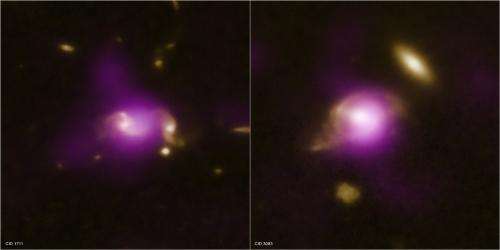Close encounters of the galactic kind

(PhysOrg.com) -- Astronomers have used a large survey to test a prediction that close encounters between galaxies can trigger the rapid growth of supermassive black holes. Key to this work was Chandra's unique ability to pinpoint actively growing black holes through the X-rays they generate.
The researchers looked at 562 pairs of galaxies ranging in distances from about 3 billion to 8 billion light years from Earth. They found that the galaxies in the early stages of an encounter with another were more likely than isolated, or "lonelier" galaxies to have actively growing black holes in their cores.
These two composite images show a sample of the pairs of galaxies that are undergoing close encounters in the survey. In these images, the data from NASA's Chandra X-ray Observatory are shown in purple and Hubble Space Telescope data are in gold. In both images, the point-like X-ray source near the center is generated by gas that has been heated to millions of degrees as it falls toward a supermassive black hole located in the middle of its host galaxy. The other faint X-ray emission may be caused by hot gas associated with the pair of galaxies.
The authors of the study estimate that nearly one-fifth of all moderately active black holes are found in galaxies undergoing the early stages of an interaction. This leaves open the question of what events are responsible for fueling the remaining 80% of growing black holes. Some of these may involve the late stages of mergers between two galaxies. Less violent events such as gas falling in from the halo of the galaxy, or the disruption of small satellite galaxies are also likely to play an important role.
The survey used in this research is called the Cosmic Evolution Survey (COSMOS), which covers two square degrees on the sky with observations from several major space-based observatories including Chandra and Hubble. Accurate distance information about the galaxies was also derived from optical observations with the European Southern Observatory's Very Large Telescope. The researchers compared a sample of 562 galaxies in pairs with 2726 solo galaxies to come to their conclusions.
A paper describing this work has been accepted for publication in The Astrophysical Journal. The study was led by John Silverman from the Institute for the Physics and Mathematics of the Universe (IPMU) at the University of Tokyo in Japan. There are 54 co-authors from various institutions around the world.
Provided by Chandra X-ray Observatory




















